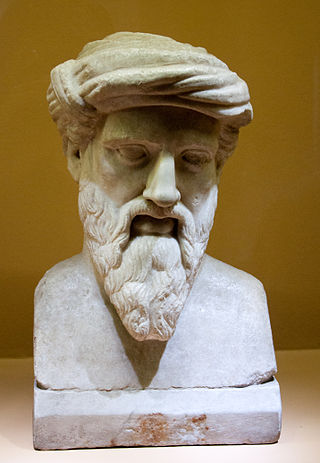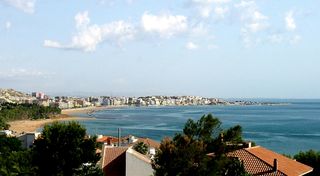Related Research Articles

Pythagoras of Samos was an ancient Ionian Greek philosopher, polymath and the eponymous founder of Pythagoreanism. His political and religious teachings were well known in Magna Graecia and influenced the philosophies of Plato, Aristotle, and, through them, the West in general. Knowledge of his life is clouded by legend. Modern scholars disagree regarding Pythagoras's education and influences, but they do agree that, around 530 BC, he travelled to Croton in southern Italy, where he founded a school in which initiates were sworn to secrecy and lived a communal, ascetic lifestyle. This lifestyle entailed a number of dietary prohibitions, traditionally said to have included aspects of vegetarianism.

Crotone is a city and comune in Calabria, Italy.

Philolaus was a Greek Pythagorean and pre-Socratic philosopher. He was born in a Greek colony in Italy and migrated to Greece. Philolaus has been called one of three most prominent figures in the Pythagorean tradition and the most outstanding figure in the Pythagorean school. Pythagoras developed a school of philosophy that was dominated by both mathematics and mysticism. Most of what is known today about the Pythagorean astronomical system is derived from Philolaus's views. He may have been the first to write about Pythagorean doctrine. According to August Böckh (1819), who cites Nicomachus, Philolaus was the successor of Pythagoras.

Pythagoreanism originated in the 6th century BC, based on and around the teachings and beliefs held by Pythagoras and his followers, the Pythagoreans. Pythagoras established the first Pythagorean community in the ancient Greek colony of Kroton, in modern Calabria (Italy). Early Pythagorean communities spread throughout Magna Graecia.
Aesara of Lucania was a conjectured Pythagorean philosopher who may have written On Human Nature, a fragment of which is preserved by Stobaeus, although the majority of critical scholars follow Holger Thesleff in attributing it to Aresas, a male writer from Lucania who is also mentioned by Iamblichus in his Life of Pythagoras.

Iamblichus was an Arab neoplatonic philosopher. He determined a direction later taken by neoplatonism. Iamblichus was also the biographer of the Greek mystic, philosopher, and mathematician Pythagoras. In addition to his philosophical contributions, his Protrepticus is important for the study of the sophists because it preserved about ten pages of an otherwise unknown sophist known as the Anonymus Iamblichi.

Hippasus of Metapontum was a Greek philosopher and early follower of Pythagoras. Little is known about his life or his beliefs, but he is sometimes credited with the discovery of the existence of irrational numbers. The discovery of irrational numbers is said to have been shocking to the Pythagoreans, and Hippasus is supposed to have drowned at sea, apparently as a punishment from the gods for divulging this and crediting it to himself instead of Pythagoras which was the norm in Pythagorean society. However, the few ancient sources who describe this story either do not mention Hippasus by name or alternatively tell that Hippasus drowned because he revealed how to construct a dodecahedron inside a sphere. The discovery of irrationality is not specifically ascribed to Hippasus by any ancient writer.
Theano was a 6th-century BC Pythagorean philosopher. She has been called the wife or student of Pythagoras, although others see her as the wife of Brontinus. Her place of birth and the identity of her father is uncertain as well. Many Pythagorean writings were attributed to her in antiquity, including some letters and a few fragments from philosophical treatises, although these are all regarded as spurious by modern scholars.
Timaeus of Locri is a character in two of Plato's dialogues, Timaeus and Critias. In both, he appears as a philosopher of the Pythagorean school. If there ever existed a historical Timaeus of Locri, he would have lived in the fifth century BC, but his historicity is dubious since he only appears as a literary figure in Plato's works; all other ancient sources are either based on Plato or are fictional accounts.
Lysis of Taras was a Greek philosopher. His life is obscure. He was said to have been a friend and disciple of Pythagoras. After the persecution of the Pythagoreans at Croton and Metapontum in Magna Graecia he escaped and went to Thebes, where he became the teacher of Epaminondas, by whom he was held in the highest esteem. There are, however, serious chronological difficulties with his being both a disciple of Pythagoras and the teacher of Epaminondas. Some of the commentators and doxographers have failed to distinguish between the two different anti-pythagorean revolutions: the first one around ~500, when Pythagoras himself died, and the second one fifty years later. This could clarify the source of the chronological incoherence.
Cylon may refer to:
Damo was a Pythagorean philosopher said by many to have been the daughter of Pythagoras and Theano.
Evander, born in Phocis or Phocaea, was the pupil and successor of Lacydes, and was joint leader (scholarch) of the Academy at Athens together with Telecles.
Diodorus of Aspendus was a 4th century BC Pythagorean philosopher, who probably lived after the time of Plato, and must have been still alive in 104th Olympiad, for he was an acquaintance of Stratonicus the musician, who lived at the court of Ptolemy Lagi. According to Iamblichus, He was the student or companion of the Pythagorean philosopher Aresas. Diodorus is said to have rejected the Pythagorean lifestyle and let his beard grow out, adopting something more similar to the Cynic mode of living prior to its endorsement by Diogenes.
Phintys was a Pythagorean philosopher, probably from the third century BC. She wrote a work on the correct behaviour of women, two extracts of which are preserved by Stobaeus.
Myia was a Pythagorean philosopher and, according to later tradition, one of the daughters of Theano and Pythagoras.
Arignote or Arignota was a Pythagorean philosopher from Croton, Magna Graecia, or from Samos. She was known as a student of Pythagoras and Theano and, according to some traditions, their daughter as well.
Calliphon of Croton, Magna Graecia, was a Pythagorean physician. He was apparently the chief priest at Croton and a man of great importance in civic affairs. Hermippus reports that he was an associate of Pythagoras, and he appears in Iamblichus's catalogue of Pythagoreans; thus he is one of the few Pythagoreans who can be dated from the time of Pythagoras. Josephus quotes Hermippus as saying that Pythagoras claimed that the soul of Calliphon of Croton used to remain at his side night and day, and that he used to utter the following advice: not to pass over a place where his donkey had stumbled, to drink only of clear fountain water, and to speak ill of no man. Herodotus, in telling the story of the physician Democedes of Croton, reports that Democedes was the son of Calliphon.
Aresas of Lucania, and probably of Croton in Magna Graecia, was the head of the Pythagorean school, and the sixth head of the school in succession from Pythagoras himself. Diodorus of Aspendus was one of his students. He lived around the 4th or 5th century BCE.

The Italian School of Pre-Socratic philosophy refers to Ancient Greek philosophers in Italy or Magna Graecia in the 6th and 5th century BC. The doxographer Diogenes Laërtius divides pre Socratic philosophy into the Ionian and Italian School. According to classicist Jonathan Barnes, "Although the Italian 'school' was founded by émigrés from Ionia, it quickly took on a character of its own." According to classicist W. K. C. Guthrie, it contrasted with the "materialistic and purely rational Milesians."
References
- ↑ E. Robinson, Democracy Beyond Athens, Cambridge 2011, p. 108.
- ↑ Robinson, Eric W (1997). The First Democracies: Early Popular Government Outside Athens. Stuttgart: Franz Steiner Verlag. p. 76. ISBN 9783515069519.
- ↑ Knowles, George (2 February 2008). "Old Masters of Academia: Pythagoras". Controverscial. Archived from the original on 17 July 2023. Retrieved 2 July 2016.